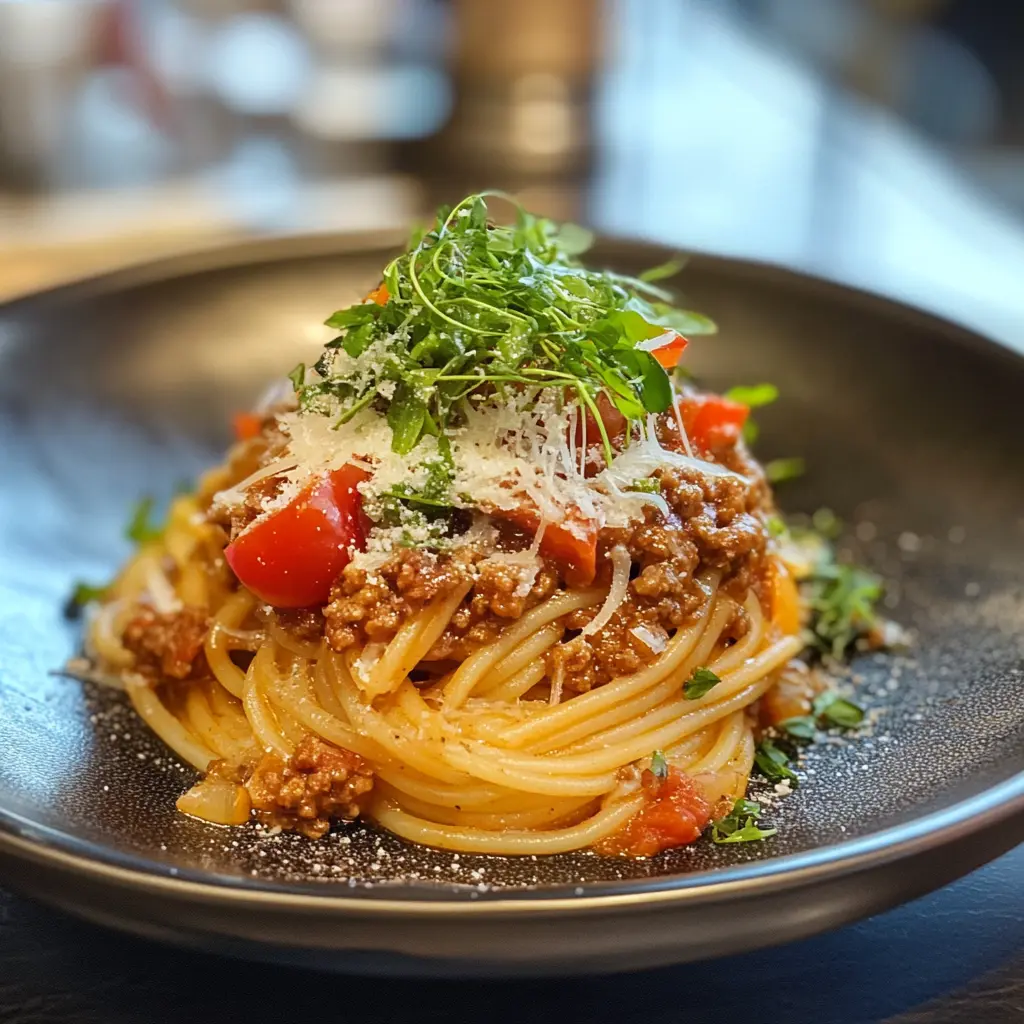Spaghetti Bolognese is one of those dishes that transcends cultures and generations. Whether it’s a cozy family dinner or a comforting meal after a long day, this Italian-inspired dish has earned its place as a global favorite. In this blog post, we’ll explore everything you need to know about Spaghetti Bolognese—from its origins and key ingredients to tips for perfecting your sauce and storing leftovers.
What is Spaghetti Bolognese?
A Classic Italian Dish
Spaghetti Bolognese, often simply called “spag bol,” is a hearty pasta dish featuring spaghetti noodles topped with a rich, meaty tomato-based sauce. While many people associate it with Italy, its roots are slightly more nuanced. The dish draws inspiration from traditional Italian cooking but has evolved into a global phenomenon with countless variations.
The name “Bolognese” refers to the city of Bologna in northern Italy, where ragù alla bolognese—a slow-cooked meat sauce—is said to have originated. However, authentic Italian recipes typically pair this sauce with tagliatelle rather than spaghetti. Over time, spaghetti became the preferred choice outside Italy due to its widespread availability and ease of preparation.
Today, Spaghetti Bolognese is beloved worldwide because it combines simple, wholesome ingredients into something truly satisfying. It’s a dish that brings people together, whether served at casual weeknight dinners or special gatherings.
Key Ingredients You’ll Need
To create an unforgettable Spaghetti Bolognese, you’ll need a few essential ingredients. Each plays a crucial role in building layers of flavor:
- Ground Beef: This forms the foundation of the sauce. Opt for lean ground beef to keep the dish balanced without being overly greasy.
- Tomatoes: Fresh or canned tomatoes provide the base for the sauce. San Marzano tomatoes are highly recommended for their sweet, tangy flavor.
- Onions, Carrots, and Celery: Known as the “holy trinity” in Italian cooking, these vegetables add natural sweetness and depth to the sauce.
- Garlic: A staple in Mediterranean cuisine, garlic infuses the dish with aromatic notes.
- Olive Oil: High-quality olive oil not only prevents sticking but also enhances the overall taste.
- Parmesan Cheese: Grated Parmesan adds a salty, nutty finish that ties everything together.
- Herbs: Basil, oregano, and bay leaves contribute freshness and complexity.
These ingredients work harmoniously to create a sauce that’s both comforting and sophisticated.
Common Misconceptions About Spaghetti Bolognese
There are several misconceptions surrounding Spaghetti Bolognese, especially regarding its authenticity and preparation. Let’s clear up some common myths:
- Is It Truly Italian? While the concept of pairing pasta with a meaty tomato sauce is Italian, the specific combination of spaghetti and Bolognese sauce isn’t traditionally Italian. Authentic ragù alla bolognese is usually served with flat pasta like tagliatelle. That said, there’s no denying the deliciousness of spaghetti paired with this sauce!
- Does It Have to Be Complicated? Many home cooks mistakenly believe that making Spaghetti Bolognese requires hours of effort. While slow-cooking does enhance the flavors, you can still achieve excellent results with quicker methods by using quality ingredients.
- What Makes It Different From Other Pasta Dishes? Unlike lighter tomato sauces, Bolognese is thicker and heartier due to the inclusion of ground meat and finely chopped vegetables. Its texture and depth set it apart from marinara or arrabbiata sauces.
Understanding these nuances will help you appreciate the dish even more—and feel confident experimenting with your own twist.
How to Make the Perfect Spaghetti Bolognese
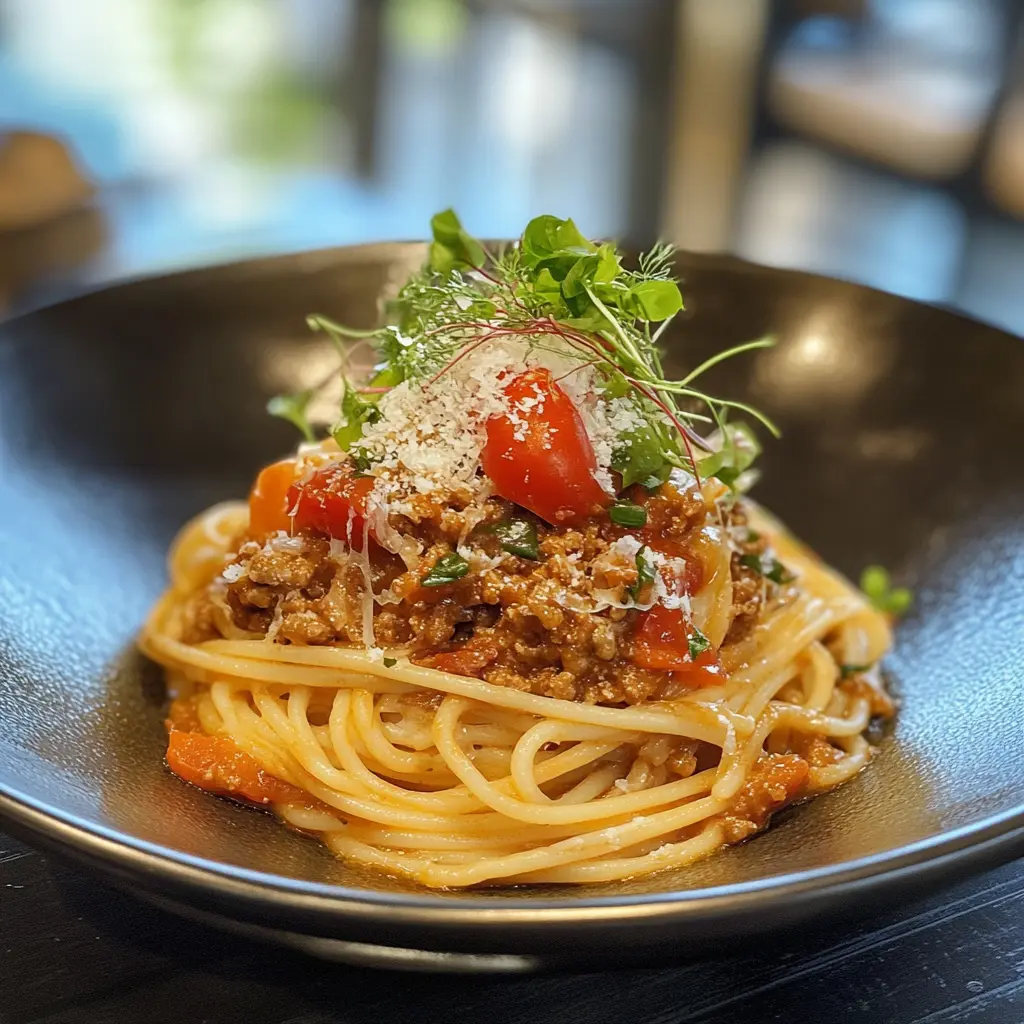
Step-by-Step Guide to Making the Sauce
Creating the perfect Bolognese sauce involves layering flavors through careful cooking techniques. Here’s how to do it step-by-step:
- Start with Browning the Meat: Heat a splash of olive oil in a large skillet or pot over medium heat. Add the ground beef, breaking it apart with a wooden spoon until it’s evenly browned. This process caramelizes the proteins, adding richness to the sauce.
- Sauté the Vegetables: Once the meat is cooked, remove it temporarily and sauté diced onions, carrots, and celery in the same pan. These vegetables form the backbone of the sauce, providing sweetness and balance. Stir occasionally until they’re soft and fragrant.
- Combine Everything: Return the browned meat to the pan and mix it with the vegetables. Add minced garlic for extra aroma, followed by crushed tomatoes or tomato paste. Stir well to combine, then let the mixture simmer gently for at least 30 minutes—or longer if time allows. This slow cooking melds the flavors beautifully.
- Season Thoughtfully: Finish the sauce with dried herbs like basil and oregano, along with salt and pepper to taste. For added depth, consider a pinch of sugar to counteract any acidity from the tomatoes.
By following these steps, you’ll end up with a velvety, flavorful sauce that clings perfectly to the spaghetti.
Cooking the Perfect Spaghetti
Cooking spaghetti might seem straightforward, but small details can make a big difference:
- Use Plenty of Water: Fill your pot generously with water—about 4-6 quarts per pound of pasta. This ensures the noodles cook evenly without sticking.
- Salt Generously: Add a generous amount of salt to the boiling water; it seasons the pasta from within. Aim for about 1-2 tablespoons per gallon of water.
- Stir Frequently: After adding the spaghetti, give it a quick stir to prevent clumping. Continue stirring occasionally during the first few minutes of cooking.
- Check for Doneness: Cook the pasta until it’s al dente, meaning it retains a slight firmness when bitten. Overcooked pasta becomes mushy and loses its texture.
Drain the spaghetti thoroughly but avoid rinsing it, as the residual starch helps the sauce adhere better.
Assembling the Dish
Now comes the fun part—bringing everything together:
- Toss the Pasta with Sauce: Instead of simply pouring the sauce over the spaghetti, toss them together in a warm pan. This ensures every strand is coated evenly.
- Add Finishing Touches: Sprinkle freshly grated Parmesan cheese over the top, followed by torn basil leaves for freshness. If desired, drizzle a little olive oil for shine and richness.
- Serve Immediately: Plate the spaghetti generously and garnish with additional Parmesan and basil. Serve hot alongside your chosen sides for a complete meal.
Variations to Try
While classic Spaghetti Bolognese is always a winner, don’t hesitate to experiment with variations:
- Vegetarian Option: Replace the ground beef with lentils or finely chopped mushrooms for a plant-based version.
- Creamy Twist: Stir in a dollop of cream or mascarpone cheese for a luxurious texture.
- Gluten-Free Alternative: Use gluten-free spaghetti made from rice, corn, or chickpeas to cater to dietary restrictions.
These tweaks allow you to customize the dish while maintaining its essence.
Tips for Elevating Your Spaghetti Bolognese
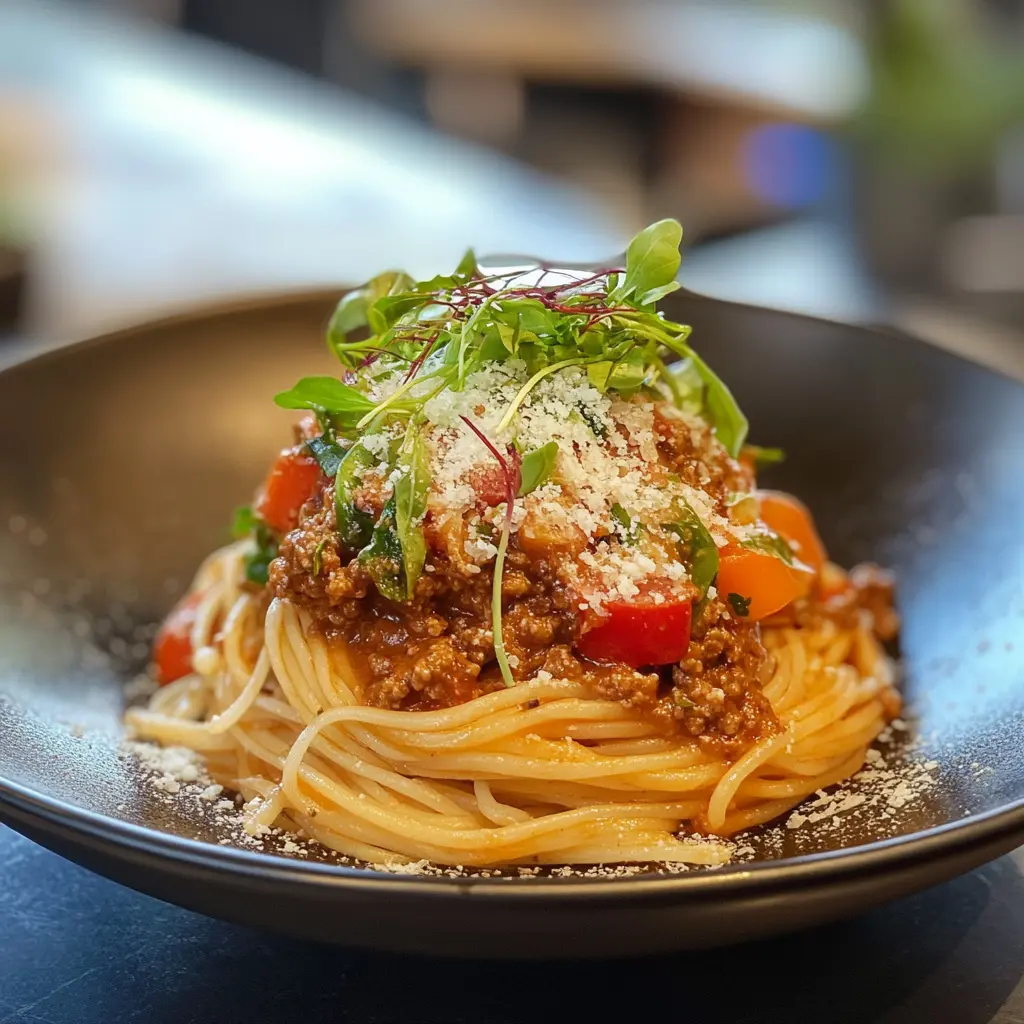
Secret Ingredients for Maximum Flavor
Elevating your Spaghetti Bolognese doesn’t require exotic ingredients—just thoughtful additions:
- Beef Broth: Instead of plain water, use beef broth to deglaze the pan after browning the meat. This intensifies the savory notes.
- Tomato Paste: Adding a tablespoon or two of concentrated tomato paste boosts the umami factor.
- Fresh Herbs: Incorporate fresh herbs like thyme or rosemary toward the end of cooking for a burst of fragrance.
These small touches transform a good sauce into a great one.
How Long Should You Simmer the Sauce?
Simmering time directly impacts the sauce’s flavor profile:
- Quick Method (30 Minutes): Ideal for busy nights, this approach yields a tasty sauce but lacks the depth of longer cooking.
- Standard Method (1-2 Hours): Allowing the sauce to simmer slowly develops complex flavors as the ingredients meld together.
- Signs It’s Ready: The sauce should thicken slightly and develop a deep, inviting aroma. Taste regularly to gauge progress.
Patience pays off here—longer simmering equals richer results.
Pairing Drinks with Spaghetti Bolognese
Choosing the right drink complements the dish beautifully:
- Sparkling Water with Lemon: Refreshing and light, this pairs wonderfully with the hearty sauce.
- Herbal Iced Tea: Mint or chamomile tea offers a soothing contrast to the robust flavors.
- Citrus-Based Cocktails: A zesty lemonade or mocktail cuts through the richness of the meal.
These options ensure your beverage enhances rather than overwhelms the dining experience.
If you’re looking for another fantastic take on this classic dish, be sure to check out this detailed guide on Spaghetti Bolognese by RecipeTin Eats . Their step-by-step instructions and expert tips will inspire your next culinary adventure!
Storing and Reheating Leftovers
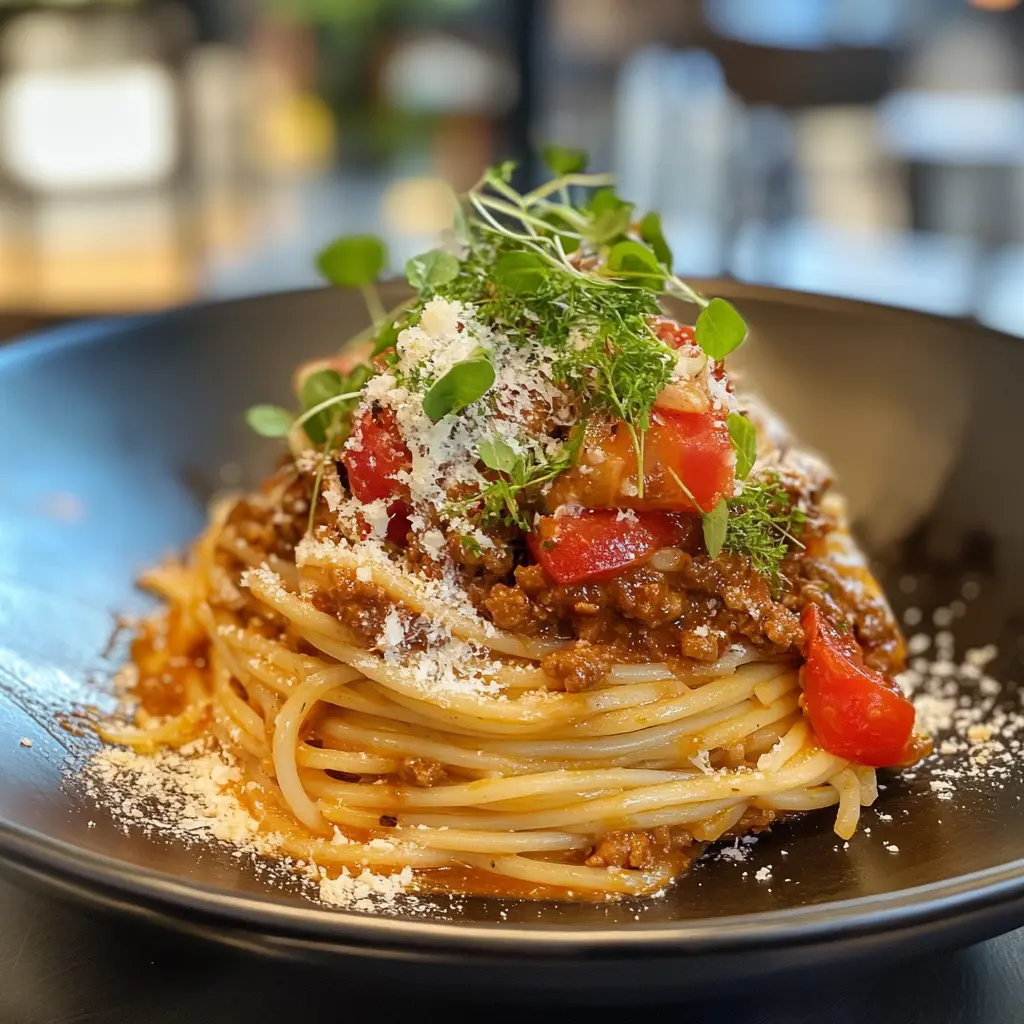
Proper Storage Techniques
Leftover Spaghetti Bolognese can be stored safely with proper care:
- Refrigeration: Transfer cooled portions to airtight containers and refrigerate within two hours. Consume within 3-4 days.
- Freezing: Portion the sauce into freezer-safe bags or containers. Label them with dates and freeze for up to three months.
- Reassembly Tips: Store the sauce and pasta separately to maintain texture.
These practices extend the life of your dish while preserving its quality.
Reheating Without Losing Flavor
Reheating properly ensures leftovers taste just as good:
- Stovetop Method: Gently reheat the sauce in a pan with a splash of water or broth to loosen it.
- Microwave Method: Cover the dish loosely to trap steam, which prevents drying out.
- Reviving Dried-Out Pasta: Toss reheated spaghetti with a bit of olive oil or sauce for moisture.
With these techniques, your leftovers will remain delicious.
Creative Ways to Repurpose Leftovers
Don’t let leftover Spaghetti Bolognese go to waste—repurpose it creatively:
- Baked Pasta Casserole: Layer the pasta and sauce with mozzarella cheese and bake until bubbly.
- Lasagna Base: Use the sauce as a filling between lasagna sheets for an easy twist.
- Hearty Soup: Thin the sauce with broth and add veggies for a comforting soup.
These ideas breathe new life into leftovers.
Frequently Asked Questions About Spaghetti Bolognese
Can I Make It Vegetarian?
Absolutely! Swap the ground beef with plant-based alternatives like lentils, black beans, or finely chopped mushrooms. You can also bulk up the sauce with diced zucchini, eggplant, or spinach for added nutrition.
How Do I Thicken My Bolognese Sauce?
If your sauce is too thin, try these tricks:
- Reduce It: Let the sauce simmer uncovered to evaporate excess liquid.
- Add Tomato Paste: Stir in a spoonful for instant thickening.
- Cornstarch Slurry: Mix cornstarch with cold water and whisk it into the sauce for quick results.
These methods ensure your sauce achieves the ideal consistency.
What Are the Best Side Dishes to Serve?
Complement your Spaghetti Bolognese with these sides:
- Garlic Bread: Crispy, buttery slices are perfect for soaking up sauce.
- Green Salad: A simple Caesar or mixed greens salad provides a refreshing contrast.
- Roasted Veggies: Seasonal vegetables like broccoli or bell peppers add color and nutrients.
These pairings round out the meal beautifully.
How Can I Make It Healthier?
For a healthier take, consider these adjustments:
- Lean Protein: Use ground turkey or chicken instead of beef.
- Low-Sodium Options: Choose low-sodium canned tomatoes and broths to reduce salt intake.
- More Veggies: Incorporate leafy greens like kale or Swiss chard for extra fiber and vitamins.
These swaps make the dish lighter without sacrificing flavor.
Conclusion
Spaghetti Bolognese is more than just a dish—it’s a celebration of simplicity, flavor, and tradition. Whether you’re a seasoned home cook or a beginner in the kitchen, this comforting pasta classic offers endless opportunities for creativity while remaining approachable. From mastering the art of crafting a rich, hearty sauce to experimenting with vegetarian alternatives or healthier twists, there’s something for everyone to enjoy.
By understanding the key ingredients, cooking techniques, and storage tips outlined in this guide, you can elevate your Spaghetti Bolognese to restaurant-quality levels. And with creative ideas for repurposing leftovers or pairing sides, you’ll never run out of ways to keep this dish exciting.
So, roll up your sleeves, gather your ingredients, and get ready to create a meal that will warm hearts and satisfy appetites. Whether it’s a quick weeknight dinner or a special occasion feast, Spaghetti Bolognese is sure to bring comfort and joy to your table. Buon appetito!
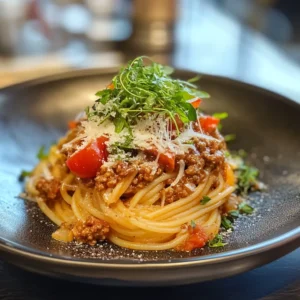
Spaghetti Bolognese
Equipment
- Large pot for boiling pasta
- Skillet or Dutch oven (for making the sauce)
- Wooden spoon or spatula
- Knife and cutting board (for chopping ingredients)
- Colander (for draining pasta)
- Measuring cups and spoons
Ingredients
- For the Sauce:
- 1 pound ground beef or a mix of beef and pork
- 1 medium onion diced
- 2 garlic cloves minced
- 2 medium carrots finely diced
- 2 celery stalks finely diced
- 1 can 28 oz crushed tomatoes
- 1 can 6 oz tomato paste
- 1 cup beef broth or red wine, optional
- 1/4 cup milk optional, for creaminess
- 2 tablespoons olive oil
- 1 teaspoon dried oregano
- 1 teaspoon dried basil
- 1 bay leaf
- Salt and pepper to taste
- Fresh parsley chopped, for garnish
- For the Pasta:
- 12 ounces spaghetti or your preferred pasta
- Salt for boiling water
- Grated Parmesan cheese for serving
Instructions
- Cook the Pasta :
- Bring a large pot of salted water to a boil. Cook the spaghetti according to package instructions until al dente. Drain and set aside.
- Prepare the Sauce :
- Heat olive oil in a skillet or Dutch oven over medium heat. Add the diced onion, garlic, carrots, and celery. Sauté for 5–7 minutes until softened.
- Add the ground beef to the skillet, breaking it into small pieces with a wooden spoon. Cook until browned and no longer pink. Drain excess grease if needed.
- Stir in the tomato paste and cook for 1–2 minutes to deepen the flavor.
- Add the crushed tomatoes, beef broth (or red wine), milk, oregano, basil, bay leaf, salt, and pepper. Stir well to combine.
- Simmer the Sauce :
- Reduce the heat to low and let the sauce simmer uncovered for 30–45 minutes, stirring occasionally. The longer it simmers, the richer the flavor will be.
- Remove the bay leaf before serving.
- Combine and Serve :
- Toss the cooked spaghetti with the Bolognese sauce, or serve the sauce on top of the pasta.
- Garnish with freshly chopped parsley and grated Parmesan cheese before serving.
Notes
Use gluten-free pasta for a gluten-free version.
Store leftovers in an airtight container in the refrigerator for up to 3 days. Reheat gently on the stovetop, adding a splash of broth or water to loosen the sauce.
Freeze portions of the sauce for up to 3 months. Thaw overnight in the refrigerator before reheating.

